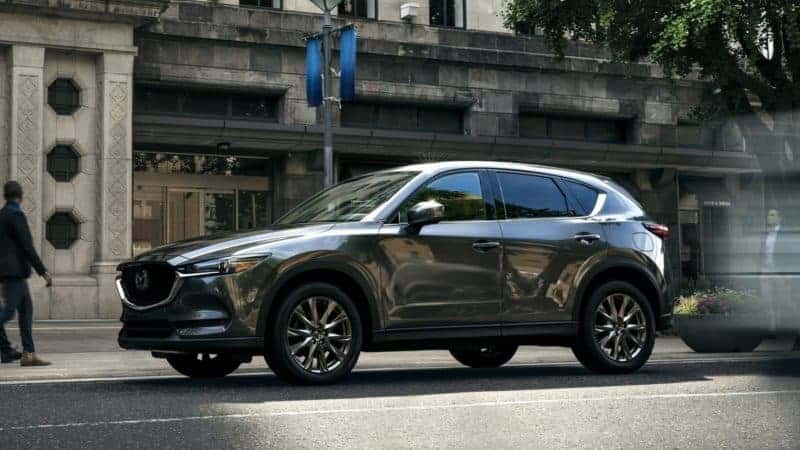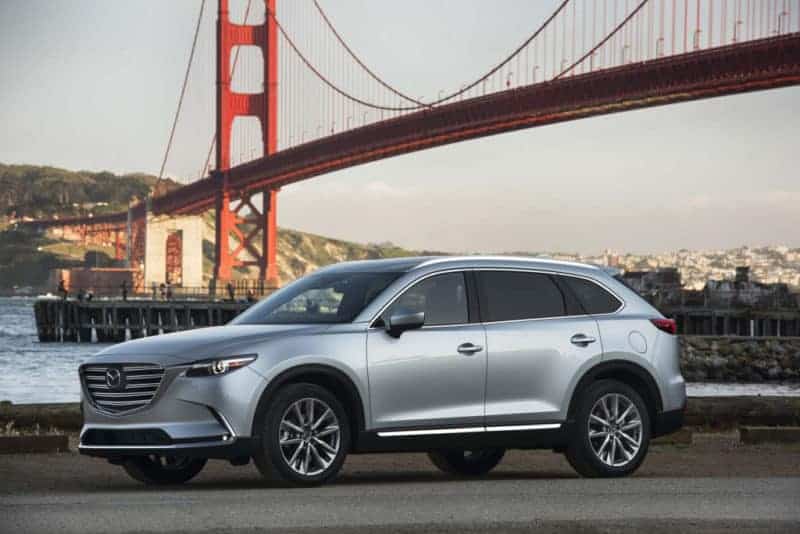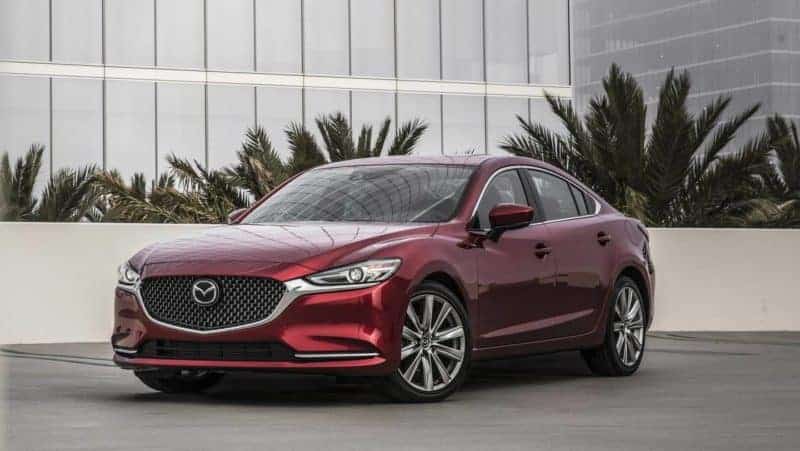Mazda is enjoying its best period in history on a global scale with 2017 total sales reaching 1.57 million vehicles and 2018 sales stopping at 1.63 million units. Considering its humble origins, that’s quite a feat for the Japanese automaker which is now officially the 14th largest car brand in the world. Broken down to separate regions, the Japanese have enjoyed the most success in North America where they’ve delivered 435,000 vehicles. China, Europe, and Japan followed up with 322,000, 269,000, and 210,000 units respectively, while the remaining 394,000 cars have been, more or less, evenly distributed across the rest of the world. With this positive trend lasting for a while now, it’s safe to expect the company will continue to grow. Here, we’ll focus on 2020 Mazda models and what they’re expected to bring to the lineup.
With North America leading Mazda sales, it doesn’t come as a surprise that the company has enjoyed some success in the region’s largest market as well. The 2018 U.S. sales stopped at 300,325 units which is a 3.75 percent increase over 2017 when the Japanese had sold 289,470 new vehicles here. Commendable as it may be, this result is still short of the company’s most recent high of 319,183 sold vehicles in 2015. Not to mention the all-time high from 1986 when the Japanese had managed to market 380,326 Mazdas in the U.S.
The recent introduction of the next-generation Skyactiv-X engine based on the homogeneous charge compression ignition (HCCI) technology has thrust the brand back into the limelight as the industry’s number one innovators at the moment – at least when it comes to the good-old-fashioned internal combustion engine. This should help them gather even more momentum in the sales race with other Japanese carmakers despite the fact the new technology is yet to prove itself.
The company is also planning on incorporating some sort of electrification level in all of its production vehicles by 2030. However, the ratio between hybrid and fully electric vehicles is expected to be 95-5 percent which clearly states Mazda’s intentions to cling to the internal combustion engine for foreseeable future. This actually doesn’t come as a surprise considering they’re investing large amounts into the conventional engine’s R&D, as evidenced by the aforementioned Skyactiv-X mill.
Without further ado, here’s what to expect from the Mazda range during MY 2020.
You might also want to browse through a selection of some of the coolest Japanese cars of each decade since 1960s and Mazda’s contribution.
What’s Hot in the New 2020 Mazda Lineup
05. 2020 Mazda 3
The thrilling compact sedan and hatchback Mazda 3’s are serving as test beds for the above-mentioned Skyactiv-X technology. In order to bring them up to speed, the Japanese have also decided to give their compacts a new look by further radicalizing what’s already a bold design.
The next-gen Mazda 3 was unveiled at the 2018 Los Angeles Auto Show and immediately announced its candidacy for the beauty pageant as arguably the most beautiful non-luxury car in and beyond its segment (although some will find the new design somewhat polarizing). Apart from obvious design changes, the new models are also longer than their predecessors.
The overhauled interior is more upscale than ever with special attention paid to ride quality and sound insulation. However, in order to achieve this, the Japanese had to ditch the outgoing model’s independent rear suspension and adopt a torsion beam setup instead. This will significantly impact the 3’s handling ability and ride enjoyment which was one of the nameplate’s strongest suits in recent years.
Finally, the all-new Mazda 3 offers a host of safety features and driver’s aids including a cross-traffic alert and a Cruising and Traffic Support system that offers a higher level of autonomous driving compared to the previous version.
The main point of emphasis with the new Mazda 3 is still the new diesel-type petrol engine which maximizes fuel efficiency while keeping power in check at the same time. Displacing 2.0 liters, the revolutionary engine generates 178 hp and 164 lb-ft of torque in Europe. It came as a late availability option limited to range-topping models overseas, but hasn’t yet been made available in the U.S. When it does finally arrive stateside, it should deliver even more power than its European sibling – 187 hp and 169 lb-ft are apparently what we can expect from this little engine that could.
Apart from the Skyactiv-X mill, the new Mazda 3 offers a new version of the Skyactiv-G 2.5L 4-cylinder engine which develops 186 hp and 186 lb-ft of torque. Both units will be available with both the manual and automatic transmissions, as well as with both the front and all-wheel drive – another first for the Mazda 3.
Sadly, all these improvements also translate to increased prices as the new model costs almost $3,000 more to begin with. The entry-level Mazda 3 for 2019 and 2020 starts from just under $22,000, while the fully loaded models top out at $30,000. What’s more, the optional Skyactiv-X engine will further increase the compact’s already unpopular price point once it arrives at some point beyond MY 2020.
Broken down, some of the improvements will cost as follows: $1,000 for the hatchback body style ($1,600 at the base level which is exclusively reserved for sedans), $1,400 for all-wheel drive, and a still-undisclosed sum (but likely higher than both) for the new engine. All-in-all the 2020 Mazda Mazda3 delivers some sublime upgrades that should prove to be highly celebrated, but you won’t be able to avoid paying for them.

04. 2020 CX-30
All-new for model year 2020, the CX-30 fills a gap between the subcompact CX-3 and compact CX-5. Although its name is confusing, the strategy behind the compact crossover isn’t. It’s exactly what the company needs to remain competitive in today’s market. Especially after a downturn in 2019, sales-wise.
Presented at the 2019 Geneva auto show, the new CX-30 borrows the aforementioned Mazda 3’s underpinnings including the new torsion beam suspension. Its powertrain lineup is also on-par with that of the recently redesigned hatchback but we’ll get to that later.
Interior mimics that of the Mazda 3 as well, and sound insulation plays an important role among the compact crossover’s novelties. We can probably expect the same in future revisions to the remainder of the Mazda range.
Most CX-30’s will be ordered with a 186-horsepower 2.5L 4-cylinder engine that’s tied to a 6-speed automatic gearbox. Front-wheel drive might be standard, but the optional equipment list will include an all-wheel drive setup.
At a later date, the newest Mazda crossover will also offer the mentioned Skyactiv-X engine, but when exactly is still unknown. The new engine is already selling like hot cakes in Europe but there’s still no confirmation on its arrival to the U.S. market.
The all-new 2020 Mazda CX-30 should arrive to dealerships in early 2020 which will be a few months too late to save the company from recording what seems like a significant loss in sales compared to previous year (if first three quarters of 2019 are any indicator), but better late than never.

03. 2020 MX-5 Miata 30th Anniversary Edition
Introduced in 1989, one of the most popular affordable compact sports cars celebrates its 30th anniversary this year. To commemorate the occasion, the Japanese have introduced a special, limited run MX-5 30th Anniversary Miata which has, sadly, already been spoken for. All 3,000 of them (500 for the U.S. market), that is.
Apart from a special Racing Orange paint, the special edition Miata sports unique 17-inch wheels, Brembo brakes, and Bilstein shocks and dampers that are only available with a stick. The interior is furbished in Alcantara leather with orange stitching and special Recaro seats.
If this info somehow still concerns you, the entry-level convertibles were available for $34,995, while the RF units went for $37,595. An optional automatic transmission warranted $500, or $400 more respectively, depending on a model. If this has somehow sparked your desire for ownership of a sports car which, let’s face it, slumbers in all of us, the regular fourth-generation Miatas are still available for as little as $26,500.
There’s nothing under the special edition MX-5’s hood that sticks out of the ordinary. Like any recently refreshed Miata, the 30th Anniversary Edition also sports an upgraded version of a 2.0L inline-four engine making 181 horsepower and 151 pound-feet of twist.
Most of the world gets this setup, but a few Japanese-based buyers have also been given the opportunity to select the base 1.5L 4-cylinder engine. This unit makes only 129 horsepower, but Miata’s sharp handling and joyous driving dynamics more than make up for this shortcoming.
Even though the current-generation models are nearing the end of their run and the next-gen units beckon, an uncool Miata is a phrase that doesn’t exist in a dictionary and 2020-year models are no different.

02. 2020 CX-5
The compact CX-5 is arguably the most fun-to-drive two-row crossover on the market and the recent addition of a more powerful turbocharged engine has made it even better. The current-generation CX-5 was introduced in 2017, and although it doesn’t bring any visual changes, MY 2020 does provide a few significant upgrades alongside price increase across the board.
Apart from being a fun house on wheels, the best-selling Mazda model with 150,622 units marketed in 2018 boasts an upscale cabin with lots of available features. The Apple CarPlay and Android auto are still only optional on entry-level models, but every CX-5 now comes with the i-Activsense safety bundle integrated from the get-go. Among other features, it includes adaptive cruise control and lane-keeping assist.
The base Mazda CX-5 Sport now starts from $26,135 (after the $1,045 destination charge) which is $740 increase over last year’s price tag. The new top-tier Signature models cost $38,100 (after a marginal $165 increase), and they also come with mandatory all-wheel drive.
The new turbocharged engine in question displaces 2.5 liters, and cranks up 250 horsepower and 320 lb-ft of rotational force (up 10 lb-ft compared to 2019). It’s exclusively available with the new and expensive Grand Touring Reserve and Signature trims, and pairs with the all-wheel-drive system. The engine does exhibit a slightly noticeable turbo lag but it propels the 3,825-pounder to 60 mph in 7.3 seconds.
The remainder of the CX-5 range uses a naturally aspirated version of a 2.5L 4-cylinder which is good enough for 187 horsepower and 186 lb-ft of torque. They’re also available with all-wheel drive, but come standard in a front-wheel-drive configuration. A 6-speed automatic gearbox shifts gears effortlessly in both of the available configurations.
It’s also worth noting that the non-turbo engine earns up to 28 mpg combined in a front-wheel-drive setup while the more powerful turbocharged engine is rated at 24 mpg combined. However, they’re both supposed to be surpassed by the all-new diesel engine which Mazda still keeps under wraps.
The initial CX-5’s 2.2L turbo-diesel was supposed to be the company’s first such offering in the U.S. as early as in 2017, but poor EPA fuel economy estimates have made Mazda rethink their strategy. They still haven’t scrapped the project but we neither know which engine they’ll actually use nor when, for that matter. It’s expected it’ll arrive during the second half of MY 2020, however, which means the 2020 Mazda CX-5 could be something to look forward to.

01. 2020 CX-9
True to company’s philosophy, the CX-9 is one of the sportiest models in its class. It boasts the most agile ride among three-row crossovers but doesn’t come without issues of its own. There’s less cargo and passenger space in CX-9 than you’ll find in its competitors and it’s also worth noting its below-average tow ratings of only 3,500 pounds.
The CX-9 is gorgeous inside and outside, however, and almost borders on luxury – especially in higher trims. The entry-level models start from just under $35,000, while the most expensive Signature units cost more than $47,000. They do include a smartphone integration (finally as of 2019), blind-spot monitors, lane departure warnings, forward-collision warnings, and a 360-degree around-view camera. Also new is a better sound insulation and improved ride quality which further elevates the intermediary’s refinement.
A host of upgrades for MY 2020 also sees the i-Activsense system as standard from now on. Furthermore, the CX-9 now gets heated front seats, a power driver’s seat, rain-sensing windshield wipers, heated outside mirrors, and auto high-beams straight from the get-go. Second row captain’s chairs are another novelty for 2020 but they’re only available with the Touring and Grand Touring trims.
There’s only one engine available with the largest Mazda crossover and it makes 250 ponies and 320 lb-ft of twist. The 2.5L turbo four’s power output drops to 227 horsepower with regular fuel, however, so be prepared to pay for premium if you need that extra edge on the highway.
A 6-speed automatic is also the only available choice, but at least the CX-9 offers both front and all-wheel drive. The outdated transmission feels sluggish at times and imposes a slight penalty on the CX-9’s fuel economy figures. The mid-size crossover is good enough for 24 miles to the gallon combined with front-wheel drive, while the optional all-wheel drive setup imposes additional one-point penalty.

What’s Not in the New 2020 Mazda Lineup
02. 2020 CX-3
The crossover hasn’t performed at the expected level – at least when it comes to U.S. sales which only amounted to 16,899 units in 2018 – but all that might change soon as the Japanese are preparing an updated version of the subcompact.
They’ve already unveiled the above mentioned CX-30 in Geneva which is why the smaller CX-3 hasn’t gotten their attention this year. Initial reports suggested that the new model is in the works but that turned out to be the larger crossover so we still don’t know what the Japanese have in store for the CX-3, future-wise. We do know that it carries over unchanged into 2020 after receiving a facelift in 2019.
At the moment, the U.S.-spec Mazda CX-3 uses a 148-horsepower 2.0L 4-cylinder engine and that’s unlikely to be changed anytime soon now that the Japanese have turned their attention elsewhere.
The CX-3 can only be ordered with a 6-speed automatic transmission and a front-wheel drive configuration which further reduces its universal appeal.
Although the all-new CX-30 encroaches on the smaller CX-3’s territory, the subcompact isn’t going nowhere. Its 2019 sales have plummeted during the first half of the year but the small crossover has rebounded since. This might not be enough for a positive balance at the end of 2019 (compared to 2018) but it’s positive news regardless.

01. 2020 Mazda 6
I never dreamed I’d have to say this but the Mazda 6 is now officially out of favor. With the mid-size sedan segment struggling against the onslaught of crossovers, the company’s managed to push only 30,938 Sixes throughout 2018. Needless to say, this figure is even lower for 2019.
Arguably the most beautiful car in its class is expected to continue with its obvious struggles in 2020 and beyond – especially after the Japanese have officially ruled out the possibility of a performance version.
Apart from being soft on the eyes, the Mazda 6 offers a good value for money, great driving dynamics, and lots of standard safety gear. The base Sport models can be had for under $25,000, while the new range-topping Signature trim requires a little bit over $36,000. Sadly, much-needed powertrain improvements come a little bit too late, and there’s still no hybrid option anywhere around.
Like most Mazda cars, the Six mostly makes do with a 2.5L Skyactiv-G 4-cylinder putting up 187 hp and 186 lb-ft of torque. A 6-speed manual is standard (6-speed auto is optional), and so is a front-wheel-drive setup. The naturally aspirated mill now also sports a cylinder deactivation system which helps it to 29 mpg combined with the auto or 27 mpg combined with a manual.
The optional 2.5L turbo four makes either 227 hp or 250 hp depending on chosen fuel type, and a healthy 320 pound-feet of torque. It’s paired exclusively with a front-wheel-drive/6-speed auto setup and manages to return 26 miles to the gallon combined.
An optional all-wheel drive setup and a 2.2L turbo-diesel 4-cylinder with 168 horsepower and 290 lb-ft of torque are a late availability package for MY 2020. This, sadly, probably won’t be enough to reverse the beautiful sedan’s fortunes.
There’s no info about the next-generation models yet, but the current-generation is expected to continue for at least a year or two more, having been introduced in 2016. Considering how sedan’s sales have plummeted in recent years, the Japanese better do something about it unless their aim is to let it simply die out. This would be such a shame, though.


